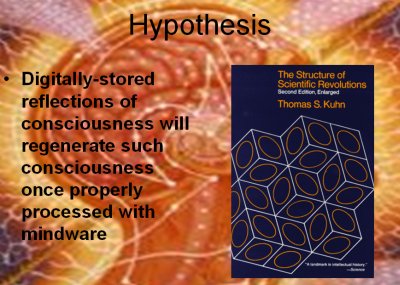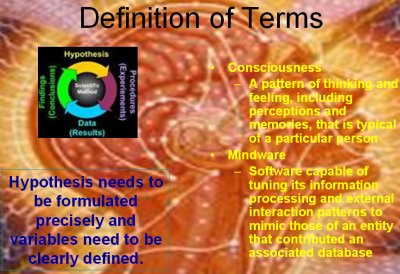An Experiment to Test the Ability of Digitally-Stored Mindfiles to Regenerate the Consciousness from Which It Came
Martine Rothblatt, Ph.D.
This article was adapted from a lecture given by Martine Rothblatt, Ph.D. during the 3rd Annual Workshop Webinar on Geoethical Nanotechnology on July 20, 2007, at the Florida Space Coast Office of Terasem Movement, Inc.
Dr. Martine Rothblatt hypothesizes on preserving life by employing nanotechnology to digitally store reflections of consciousness in machine form and the future processing with mindware to regenerate the source consciousness.
This article will look at the possibility that by using  nanotechnology [1], perhaps we could be here forever and achieve a universal consciousness. Perhaps that concept will help us be careful and judicious in our development of nanotechnology, and avoid any type of cataclysmic failure such as depicted in the book, Prey [2].
nanotechnology [1], perhaps we could be here forever and achieve a universal consciousness. Perhaps that concept will help us be careful and judicious in our development of nanotechnology, and avoid any type of cataclysmic failure such as depicted in the book, Prey [2].
For example, in order to leave the Earth and explore the cosmos, it will be necessary to take very long journeys -- much longer than can be supported by a capable human-life -- or human DNA driven bodies. One possible way to address this issue is to upload our consciousness into a machine form, and  our rocket ships could then be vastly smaller. Upon arrival at distant planetary systems, with techniques of self replicating nanotechnology, we could rebuild human-scale infrastructure and ultimately download our minds back into nano built larger-scale bodies. By doing this throughout the galaxy and beyond, we would be safe from the risk of extinction due to a local astrophysical catastrophe.
our rocket ships could then be vastly smaller. Upon arrival at distant planetary systems, with techniques of self replicating nanotechnology, we could rebuild human-scale infrastructure and ultimately download our minds back into nano built larger-scale bodies. By doing this throughout the galaxy and beyond, we would be safe from the risk of extinction due to a local astrophysical catastrophe.
A relevant immediate problem is to be able to help address the horror associated with some 200,000 people who die every single day due the failure of our DNA driven bodies. Just around the corner, ten, twenty, thirty years from now, there will be cures for many of the diseases resulting in death today. Can we somehow transport ourselves ten, twenty, thirty years into the future to avail ourselves of medicine or lifesaving techniques, that we may continue our life even if we have to skip over some decades before that's possible? To do that we would have to save our consciousness in a machine form, and then be able to regenerate it in a few decades. This article is about an experiment designed to test whether or not it is possible to achieve these kind of consciousness-keeping and revival scenarios.
The hypothesis of this experiment is that digitally stored reflections of consciousness can regenerate the source consciousness when properly processed with mindware.

Image 1
This is a valid hypothesis because it is testable, although it does challenge the current scientific paradigm that our consciousness is firmly rooted in our brain, and once those neurons are gone, so is the consciousness.
It is important to first begin with a definition of terms: By "consciousness”, I'm speaking about a pattern of thinking and feeling, including perceptions and memories, that is typical of a particular person.

Image 2
By "mindware" I'm speaking of software capable of tuning its information processing and external interaction patterns to mimic those of the entity that contributed the associated database.
Within the scientific method, terms must be formulated so precisely that the variables can be accurately measured. And so I think even this definition of terms is not precise enough for scientific measurement. I'd like to now move to a more precise definition.
Let us start with "consciousness." For our experiment, I would prefer both a quantitative and a qualitative definition.
The qualitative definition is two psychologists separately interview a flesh subject for twenty-five hours over a period of one year. Then two psychologists separately interview the cyber subject, who is the purported revival of the original subject's consciousness for another twenty-five hours over a period of one year.
The two teams of psychologists would compare their session notes and if they both agree that the consciousness of the revived individual, the cyber subject, is the same as the consciousness of the flesh individual with a probability of greater than eighty percent, then that individual would be deemed to have the same consciousness as the original individual.
We can also speak about a quantitative component to our definition. There are a number of psychological scales that have been developed to quantifiably measure consciousness. There is a self consciousness field associated with Scheier & Carver [3]. There is also a private self consciousness scale, a public self consciousness scale, and numerous other psychometric measures.
In the self consciousness scale, individuals are asked to respond to a number of questions such as: am I generally sensitive to my inner feelings, and so on. The self consciousness scales scores have proven to be highly reliable. For example, data by Fenigstein [4] published a reliability progression of .79 for the private self consciousness score, and a .84 for the public self consciousness score. In other words, the same individual who took the test at different times could reliably, with approximately a .8 probability, produce the same score.
Footnotes
1. Nanotechnology - a highly multidisciplinary field, drawing from fields such as applied physics, materials science, interface and colloid science, device physics, supramolecular chemistry (which refers to the area of chemistry that focuses on the noncovalent bonding interactions of molecules), self-replicating machines and robotics, chemical engineering, mechanical engineering, biological engineering, and electrical engineering.
http://en.wikipedia.org/wiki/Nanotechnology April 1, 2008 12:21PM EST
2. Prey - a techno-thriller novel by Michael Crichton first published in hardback edition in November 2002 and as a paperback edition in November 2003 by Harper Collins. Like Jurassic Park, the novel serves as a cautionary tale about developments in science and technology; in this case, nanotechnology. ISBN 0-00-715379-1 (first edition, hardback).
http://en.wikipedia.org/wiki/Prey_(novel) April 1, 2008 12:30PM EST
3. Scheier & Carver – The Self-Consciousness Scale: A Revised Version for Use with General Populations (1985).
http://www.psy.cmu.edu/faculty/.../SCSR_article.pdf April 1, 2008 1:36PM EST
4. Fenigstein, Scheier & Buss, 1975 - Describes the development of a scale to assess individual differences in self-consciousness. Construction of the scale involved testing the 38 initial items with 130 female and 82 male undergraduates. A principal components factor analysis of the data yielded 3 factors accounting for 43% of the variance: Private Self-Consciousness, Public Self-Consciousness, and Social Anxiety. The final version of the scale, which contained 23 items, was administered to several groups of undergraduates (N = 668) to obtain norms, test-retest (2 wks), subscale correlation, and reliability data. Test-retest reliabilities were .84 for the Public Self-Consciousness scale, .79 for the Private Self-Consciousness scale, .73 for the Social Anxiety scale, and .80 for the total score. Public Self-Consciousness correlated moderately with both Private Self-Consciousness and Social Anxiety, while the correlation of Private Self-Consciousness with Social Anxiety fluctuated around zero. No sex differences in scores were observed. Implications for research and therapy are discussed. (PsycINFO Database Record (c) 2006 APA, all rights reserved).
Journal of Consulting and Clinical Psychology
Volume 43, Issue 4, August 1975, Pages 522-527.
April 1, 2008 2:03PM EST
1 2 3 4 Next Page>